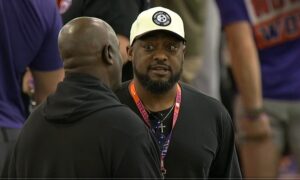On seldom occasions, and if asked the right question in the correct manner, Pittsburgh Steelers head coach Mike Tomlin can really provide some useful information to the media as well as to fans of the team. Such was the case Friday evening when Tomlin had his weekly pre-game interview with Bob Labriola of steelers.com.
In short, Tomlin was asked during his one-on-one interview to explain how special team contributions ultimately factor into final roster decisions. That quick synopsis, however, doesn’t do Labriola’s question justice so let’s look at the full question he asked Tomlin as well as the response given.
Labriola: How are contributions on special teams factored into the decisions? Is it something where you look at the players who are valuable on special teams and then factor in their play at their respective positions, or is it more the other way around, where you look at the guys at the bottom of the depth chart and determine whether they can be an asset to special teams?
Tomlin: To put it in simple terms: the further you are down the offensive or defensive depth chart, the more dynamic you better be in special teams if you have a desire to be a part of it. If you’re a second-team offensive player or defensive player, then you’ll have a role on special teams and that role needs to be useful and helpful and productive. If you’re third on the depth chart at whatever position you prescribe then you better have big-time special teams value, because there are no third-teams in the National Football League. If you look at any football team, that third-team player, whoever he might be, he’s on the roster primarily because of his special teams contributions because there’s just not a lot of depth in the NFL. So that fifth cornerback, for example, he’s more of a gunner than a cornerback. And he’s on a 53-man roster because of his ability to cover kicks, more than likely. That fifth inside linebacker, he’s more of a special teamer than he is a linebacker. If you look at our football team, you have to have position flexibility, we don’t have a backup mack linebacker and a backup buck linebacker. We have a third inside linebacker. If something happens to any of our inside linebackers, Tyler Matakevich is at this time the linebacker who goes in. So if you’re the fifth guy, you’re several plays away from playing defense, so you better be valuable in the special teams area.
Now, none of what Tomlin said is overly surprising, but with that noted, it’s always good to hear it straight from the proverbial horse’s mouth just the same. If you’ve read my posts over the years, you already know that I love to put a lot of emphasis on special teams ability when it comes to my final roster prognosticating during training camp and the preseason. With that said, I admittedly also tend to go overboard in that area. Where is the happy medium?
Let’s take a look at new Steelers wide receiver Justin Hunter and attempt to apply what Tomlin said to Labriola Friday night.
Hunter is competing for what most of us think will ultimately be a fifth or sixth wide receiver spot on the Steelers 53-man roster this year. The former second-round draft pick of the Tennessee Titans is likely competing against Sammie Coates and Darrius Heyward-Bey this year for what might be two roster spots.
While Hunter’s receiving skills can probably easily be considered better than Heyward-Bey’s and on par with Coates’, he’s certainly nowhere close to being as good of a special teams player as the two. In fact, while Hunter has only played in one preseason game so far this year, he didn’t even see the field on special teams in that contest against the Atlanta Falcons.
Coates, on the other hand, played six special teams snaps against the Falcons and Heyward-Bey, like Hunter, didn’t play any special teams snaps in that game. That fact, however, is not a big deal as not only did Heyward-Bey leave the field early in that game with what looked like a minor injury, his past play over the years on special teams already speaks volumes.
In short, pay close attention Saturday night to see if Hunter even gets a shot to contribute on special teams against the Indianapolis Colts. If I were to bet on that, I would put my money on it not happening as Hunter doesn’t have a special teams resume at all. Basically, Hunter might very well need an injury to take place during the Steelers final two preseason games for him to land a spot on the 53-man roster. Who knows, maybe the Steelers can ultimately trade Hunter to the New York Jets for a seventh-round draft pick if the wide receiver makes a few big catches in the final two preseason games.
Can we also apply what Tomlin said Friday night about special teams abilities to the linebacker depth chart? Possibly. It goes without saying that Tyler Matakevich is locked into the No. 3 spot on the inside linebacker depth chart and that Anthony Chickillo is more than likely No. 4 on the outside linebacker depth chart. Behind those two players are L.J. Fort and Steven Johnson on the inside and veteran Arthur Moats on the outside. Of those three players, how would you rank each’s special teams abilities? Personally, I would rank them Johnson, Fort and then Moats.
Last season, Johnson averaged 16.8 snaps per game that he dressed for on special teams. Fort averaged 14.8 snaps while Moats was way behind the two with an average of 4.4 special teams snaps per game. Now, Moats likely would have averaged more had he not been a starter and key contributor on defense during the first half of the season but with that said, he pretty much became a special teams after thought once Bud Dupree returned from his injury and Chickillo passed him on the depth chart.
The Steelers will likely only keep eight or nine linebackers in total this year and if that’s ultimately the case, either Johnson, Fort or Moats won’t survive the final cut.
In closing, don’t discount what Tomlin said Friday night to Labriola when it comes to special teams abilities in regard to players buried on positional depth charts as it’s a big element in determining the team’s final few roster spots.








